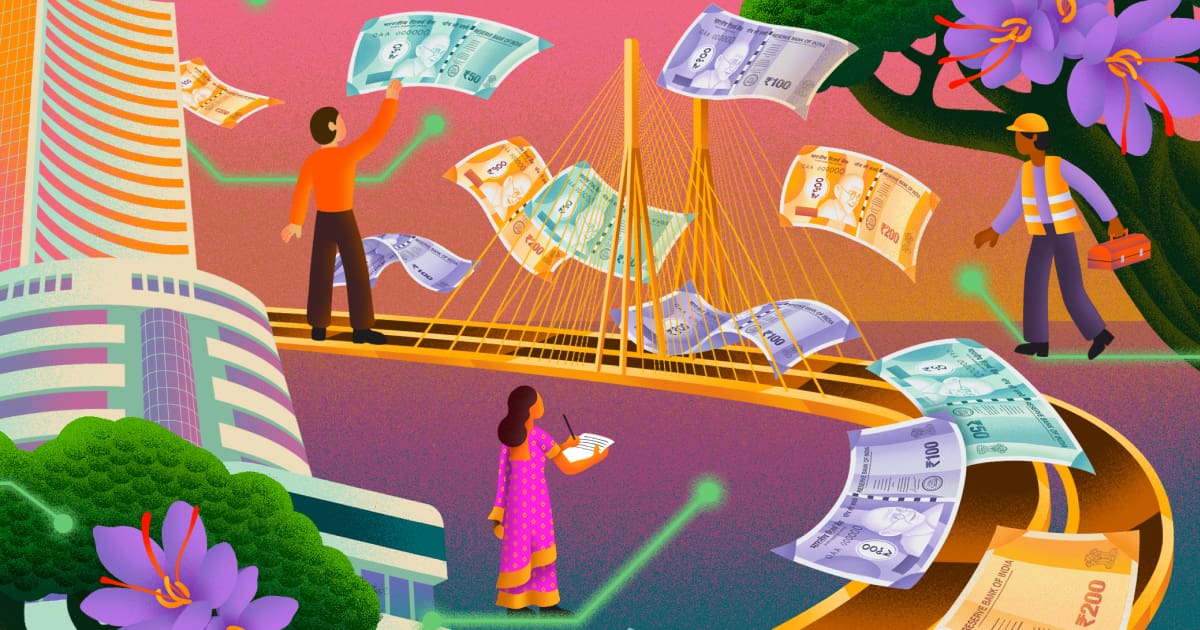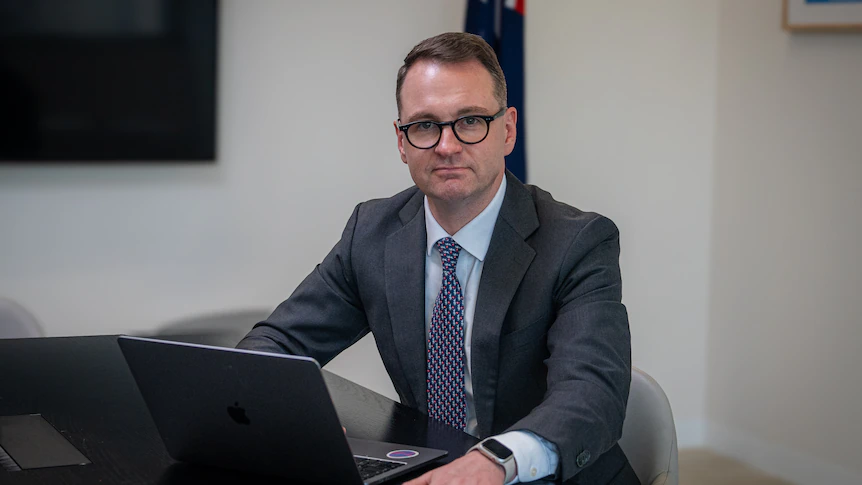
THE IDEA
Invest Now, Don’t Wait
Over the last five years, India’s equity markets have undergone a massive democratization on three levels.
We are now one of the world’s largest markets for initial public offerings. And there are millions of new retail investors, many of whom are perpetual buyers, meaning inflows into equities have increased sharply.
All these factors have made our equity markets stronger and more liquid. So regardless of the US tariffs, geopolitics and policy-related disruptions, you need to be invested in the markets and not sitting it out waiting for the right moment.
How to Invest It
Diversify across asset classes by increasing allocation to debt investments, but also including your retirement fund in the overall portfolio analysis.
Investors need to increase their allocations to mid-cap and small-cap stocks because these companies have a long road of growth ahead of them. If you were 60:30:10 across large-, mid- and small-cap companies, I would increase allocations to mid- and small-cap stocks.
Equity is no longer the only growth asset class. With gold outperforming equities and serious buying of silver, there is a commodity play taking place too due to sustained sovereign interest due to geopolitical reasons.
It is easy to invest in gold and silver, whether it is directly or through ETFs. I would suggest rethinking gold as just a hedge to equities going forward.
The Risks
Too often, investors know more about the specifications of their next car than the composition of their portfolio. Financial literacy and intention matter. Regardless of whether one invests via an adviser, distributor or digital platform, clarity on life goals, risk tolerance and return expectations is essential.
Be hands-on. Define your lifestyle aspirations and career trajectory, then align your portfolio accordingly. Chasing unrealistic returns is a recipe for disappointment; being reasonable and disciplined compounds wealth far more effectively.
THE IDEA
Protect Your Gains
Given the macro-economic environment, my advice to investors is to preserve the gains they made in the last five years. Review your portfolio to see if it still aligns with your financial goals and see if there are changes to be made to preserve your wealth. If you need to course correct, you can use 10 lakh rupees to make changes.
We see good opportunities for investors to consider extending duration and increasing allocation to fixed income portfolios, calibrated to their investment horizon.
How to Invest It
We believe that current yield levels present good opportunities for investors to extend duration and increase allocation to fixed income portfolios due to factors like an expected mismatch between duration supply and demand and the potential for further monetary easing.
Investors should increase allocation to fixed income portfolios, particularly in long-duration and state-development-loan segments, to benefit from likely yield declines and spread compression.
On the equity side, I would choose less risky options like large-cap funds and multi-asset allocation funds. A multi-asset allocation fund can invest in debt papers, equity and commodities as well as Real Estate Investment Trusts and Infrastructure Investment Trusts.
I would allocate equal amounts to a large-cap mutual fund and a multi-asset allocation fund.
On the debt side, I recommend debt plus arbitrage fund-of-funds, all-weather credit risk funds and government bond funds. The debt plus arbitrage fund-of-funds is a tax-efficient product for individuals looking to hold for more than two years.
The Risks
The 50% US tariff on some Indian imports is a concern due to its potential impact on both growth and the balance of payments. However, the implications for the fixed income market are mixed.
While currency pressure would be a negative for fixed income, the resulting drag on growth may prompt a monetary policy response. The government has not indicated any major budgetary support, and we do not expect fiscal risks to become significant.
THE IDEA
Pay Attention To Tariffs
Geopolitical tensions and tariff-related disruptions are set to keep Indian equity markets on edge over the next few quarters. While this spells volatility in the near term, it also offers a fertile ground for disciplined investors to build positions for the long haul.
The key lies in adhering to a clear asset allocation framework that is aligned with age, risk appetite and financial goals.
Investors reviewing their portfolios should pay close attention to risk, especially with volatility rising on the back of tariff-led uncertainty. While India’s markets have been the absorbing geopolitical shocks, earnings growth is likely to be tight in the coming quarters and yet valuations are still stretched. This makes equity less attractive than before.
Aim to keep a conservative approach in such times. Investors should be looking at their exposure to equities because returns over the last 12 months have been flat. Even if India can negotiate a lower tariff and that helps our exports, a global slowdown will have an overriding effect. Historically, India’s nominal GDP growth and corporate revenues have been strongly linked to global trade growth.
For someone in their early 30s, the asset allocation among equity, debt and gold can be in the ratio of 60:30:10. For someone in the mid-forties, the ratio can be 50:40:10. Similarly, someone in the late fifties can have an allocation of 40:50:10.
How to Invest It
Within equity, we currently prefer funds with a large-cap bias and those that have consumption as their primary investment theme.
Conservative investors should focus on stability while maintaining a diversified portfolio across equity, debt and gold. A higher allocation to debt is advisable, with emphasis on AAA- and AA-rated bonds or high-quality debt funds.
Equity exposure should be limited to large-cap funds or index funds, which offer steady growth with relatively lower risk. A small allocation to gold through sovereign gold bonds or ETFs adds an effective hedge against uncertainty.
Small- and mid-cap stocks, though appealing for long-term growth, are riskier at present. Many companies in this space are grappling with sluggish earnings while valuations remain elevated despite recent corrections. If a portfolio is skewed toward these segments, it may be prudent to restore balance by adding exposure to large-cap funds or index funds, which offer greater stability and resilience. I would suggest not investing in more than 10-20 mutual funds overall.
The Risks
Tariffs are borne by the buyer and consumer. So I expect inflation in the US to rise and since consumers will have to bear the cost, the US will import less. This will impact global GDP growth as the US is the largest economy and consumer.
A global slowdown and its impact on India will adversely impact even domestic cyclicals such as banking and financial services, auto and ancillaries, metals, industrials and capital goods.
Wild Card
The pandemic taught us that people should invest in their health and there is a desire to travel more. So you could spend the money on joining a gym, sports class, hiring a personal trainer or perhaps, purchase a good fitness tracker like an Apple Watch or Whoop. You could also book a wellness retreat or take an international trip. I am taking my parents to London later this year for a holiday. But if I could splurge, I may look at an expensive watch like a Rolex.
THE IDEA
Review Your Portfolio
Investors will have to be cautious in the near term. However, disruptions should be looked at as an opportunity by both businesses and investors from a long-term perspective. Strategy re-orientation will be the mantra.
Over time, market movements can distort the original asset allocation of a portfolio. Strategic rebalancing or re-orientation ensures that we revisit the portfolio from an asset allocation perspective. Portfolios are aligned as per the risk profile and investment objective, protecting capital from unintended concentration risks or overexposure to volatile asset classes.
Strategic reorientation also allows investors to participate in evolving growth opportunities, while also exercising discipline when a stock or a particular asset class has surged in one direction. By systematically trimming or locking in gains from such concentrated exposures, the portfolio avoids the risk of over-dependence on a single theme, ensuring sustainable and balanced long term returns.
How to Invest It
If you are conservative, the strategy should focus on capital preservation and generating stable, predictable returns by addressing specific risk concerns. Investors should consider instruments that aren’t directly correlated to the market’s daily fluctuations to manage volatility and minimize market swings.
That means allocating investments to a more consistent and potentially lower-return products. To ensure you do not lose your principal and manage capital loss, investors can prioritize buying highly credit rated fixed-income instruments. These are AAA and AA debentures or bonds from reputed corporate issuers.
If you want to be more aggressive then you have private credit options but these come with additional risk. You need to have a clear strategy on drawing down the money over time and avoid products with lock-in periods or a difficult exit process.
The Risks
The festive season is expected to see a boost in consumption demand which is supported by a good monsoon, lower interest rates, a reduction in tax rates across a range of goods and higher disposable income thanks to government tax incentives.
The tariffs could threaten India’s economic growth, potentially reducing GDP growth by up to 0.8 percentage points in the future, and revenue growth for companies is likely to be uneven across sectors because of domestic macro-economic conditions and global uncertainties.
There could be significant negative impact of the US tariffs on India’s micro, small, and medium enterprises particularly in labor-intensive and export-driven sectors like textiles, gems, seafood, chemicals and machinery.



